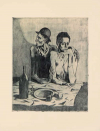Imaginary
Portraits (Portraits Imaginaires)
Pablo Picasso's Imaginary Portraits series comprises six lithographs. Created in 1969, late in his career, this series showcases Picasso's continued innovation in the realm of portraiture, presenting fantastical and stylised representations of imaginary characters. Each portrait blends elements of abstraction and Cubism with a vivid expressionistic palette, underscoring Picasso's mastery in redefining modern portraiture.
Pablo Picasso Imaginary Portraits (Portraits Imaginaires) For sale
Imaginary Portraits (Portraits Imaginaires) Value (5 Years)
Sales data across the Imaginary Portraits (Portraits Imaginaires) series by Pablo Picasso varies by print. While standout works have sold at auction for up to £3684, other editions in the series remain rare to market or have yet to appear publicly for sale. Of those tracked, average selling prices have ranged from £1237 to £3000, with an annual growth rate of 3.84% across available data. Collectors should note the discrepancy in performance between more visible and lesser-seen editions when considering value potential in this series.
Imaginary Portraits (Portraits Imaginaires) Market value
Auction Results
| Artwork | Auction Date | Auction House | Return to Seller | Hammer Price | Buyer Paid |
|---|
Sell Your Art
with Us
with Us
Join Our Network of Collectors. Buy, Sell and Track Demand
Meaning & Analysis
The Imaginary Portraits series by Pablo Picasso is a profound exploration of human expression through a lens of abstraction. Each piece in the series depicts an imaginary figure, allowing Picasso to experiment freely with facial features and expressions without the constraint of likeness. This creative freedom is evident in the exaggerated and sometimes distorted forms that characterise the series, where each portrait is imbued with a distinct emotional and psychological depth.
Picasso's technique in these lithographs involves a dynamic interplay of line and colour, with bold strokes and vibrant hues that bring each imaginary face to life. The backgrounds are typically minimalistic, focusing attention on the figures themselves, which are rendered with a complexity that suggests a narrative or persona beyond their visual form.
This series not only highlights Picasso's iconic style but also his ability to convey complex human emotions through simplified forms. The portraits, while abstract, are intensely expressive, each conveying a sense of individuality and introspection. Through these works, Picasso challenges traditional notions of portraiture, pushing the boundaries of how identity and emotion are represented in art.

